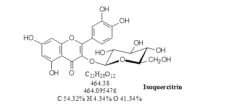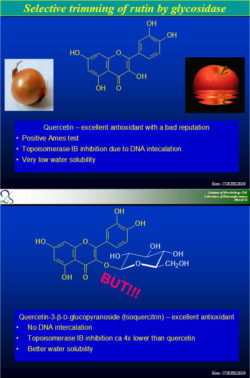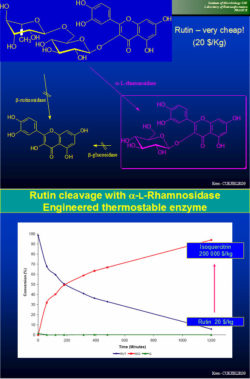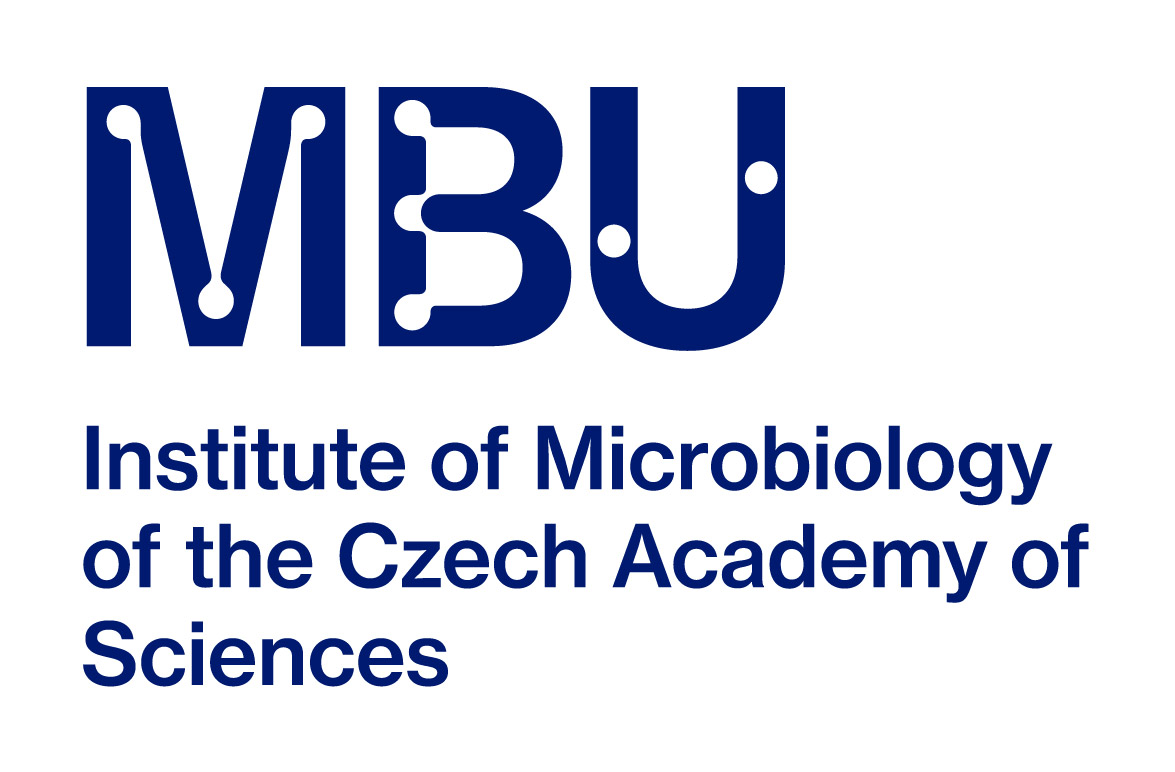
Isoquercitrin (Quercetin 3-glucoside)
- CAS No.
- 482–35–9
- IUPAC name
- 2-(3,4-dihydroxyphenyl)-5,7-dihydroxy-3-oxy-chromen-4-one
- Molecular formula
- C21H20O12
- molecular weight
- 464.4 g/mol
Quercetin and glycosides
Quercetin, a substance marketed as a food supplement, is present in many plants, but for practical purposes it is derived from rutin (quercetin-3-O-rhamnoglucoside), which is treated with acid to obtain quercetin. Rutin is isolated from the seed pods of the Brazilian shrub “fava d´anta” (Dimorphandra mollis). There is significant evidence in the literature concerning anti-proliferative and cell growth regulating properties of quercetin.

Examples of applications of Isoquercitrin
Health benefits attributed to isoquercitrin and rutin have been associated with improvement of capillary health by strengthening blood vessels, and anti-histamine like benefits. Research has shown that quercetin by itself is poorly absorbed. The Iso form of quercitrin has been shown to provide superior absorption, making it more bioavailable to the body.
Most of these studies were carried out in vitro (cell culture). Quercetin in vivo, however, is poorly resorbed from the gastrointestinal tract. Quercetin has been also identified to have some adverse effects as demonstrated e.g. by the positive Ames’ test (potential mutagen). Fortunately, another form of quercetin, isoquercitrin (quercetin-3-O-glucoside), is much better resorbed due to the carbohydrate portion of the molecule. Its increased resorption, compared to quercetin and rutin, has been amply documented in the literature.
Natural sources of Isoquercitrin
Isoquercitrin (Bioquercetin) is a naturally occurring form of quercetin. It can be found typically in apples, onions and many other fruits and vegetables. It could be considered to be a “bio-quercetin” void of potential adverse effect of quercetin.
Isoquercitrin – technology
Institute of Microbiology, CAS, Prague has developed a proprietary enzymatic technology for a selective hydrolysis of rutin into isoquercitrin. It is very robust a relatively simple technology that is biocompatible, without the use of any harmful chemicals and organic solvents.
Isoquercitrin – specification and licensing
Institute of Microbiology offers the product (isoquercitrin) in two qualities – nutraceutical (min 90 %) and high purity (min 99.5 %). We also offer licensing respective technology including the strain for enzyme production and analytical service.

Product specification (typical)
Nutraceutical Isoquercitrin
| Isoquercitrin | min. 90 % |
| Rutin | max. 3 % |
| Quercetin | max. 0.5 % |
| Ash (as sulfate) | max. 0.7 % |
| Heavy metals (as Pb) | max. 0.0015 % |
| Loss of drying | max. 7 % |
| Mycotoxins | absent |
Yellow fine amorphous powder spray-dried.
High purity Isoquercitrin
| Isoquercitrin | min. 99.5 % |
Traces of rutin and quercetin
Yellow-orange crystals.
Relevant references
- Auger C, Teissedre PL, Gerain P, Lequeux N, Bornet A, Serisier S, Besancon P, Caporiccio B, Cristol JP, Rouanet JM. Dietary wine phenolics catechin, quercetin, and resveratrol efficiently protect hypercholesterolemic hamsters against aortic fatty streak accumulation.
JOURNAL OF AGRICULTURAL AND FOOD CHEMISTRY Volume: 53 Issue: 6 Pages: 2015–2021 Published: MAR 23 2005 - Caltagirone S, Rossi C, Poggi A, Ranelletti FO,Natali PG, Brunetti M,Aiello FB, Piantelli M. Flavonoids apigenin and quercetin inhibit melanoma growth and metastatic potential.
INTERNATIONAL JOURNAL OF CANCER Volume: 87 Issue: 4 Pages: 595–600 Published: AUG 15 2000 - Formica JV, Regelson W. Review of the biology of Quercetin and related bioflavonoids.
FOOD AND CHEMICAL TOXICOLOGY Volume: 33 Issue: 12 Pages: 1061–1080 Published: DEC 1995 - Graefe EU, Derendorf H, Veit M. Pharmacokinetics and bioavailability of quercetin glycosides in humans.
INTERNATIONAL JOURNAL OF CLINICAL PHARMACOLOGY AND THERAPEUTICS Volume: 37 Issue: 5 Pages: 219–233 Published: MAY 1999 - Graefe EU, Wittig J, Mueller S, et al. Pharmacokinetics and bioavailability of quercetin glycosides in humans
JOURNAL OF CLINICAL PHARMACOLOGY Volume: 41 Issue: 5 Pages: 492–499 Published: MAY 2001 - Arts ICW, Sesink ALA, Hollman PCH Quercetin-3-glucoside is transported by the glucose carrier SGLT1 across the brush border membrane of rat small intestine
JOURNAL OF NUTRITION Volume: 132 Issue: 9 Pages: 2823–2823 Published: SEP 2002 - Hollman PCh, Bijsman MN, van Gameren Y, Cnossen EP, de Vries JH, Katan MB. The sugar moiety is a major determinant of the absorption of dietary flavonoid glycosides in man.
- Juzwiak S, Wojcicki J, Mokrzycki K, Marchlewicz M, Bialecka M, Wenda-Rozewicka L, Gawronska-Szklarz B, Drozdzik M. Effect of quercetin on experimental hyperlipidemia and atherosclerosis in rabbits.
- Kim H, Kong H, Choi B, Yang Y, Kim Y, Lim MJ, Neckers L, Jung Y. Metabolic and pharmacological properties of rutin, a dietary quercetin glycoside, for treatment of inflammatory bowel disease.
- Knowles LM, Zigrossi DA, Tauber RA, Hightower C, Milner JA Flavonoids suppress androgen-independent human prostate tumor proliferation. Nutr Cancer. 2000;38(1):116–22
- Okamoto T. Safety of quercetin for clinical application (Review).
- Shoskes D, Lapierre C, Cruz-Corerra M, Muruve N, Rosario R, Fromkin B, Braun M, Copley J. Beneficial effects of the bioflavonoids curcumin and quercetin on early function in cadaveric renal transplantation: a randomized placebo controlled trial.
- Shoskes DA. Effect of bioflavonoids quercetin and curcumin on ischemic renal injury: a new class of renoprotective agents.
- Xing N, Chen Y, Mitchell SH, Young CY. Quercetin inhibits the expression and function of the androgen receptor in LNCaP prostate cancer cells.


 Doc.RNDr. Pavla Bojarová, Ph.D.
Doc.RNDr. Pavla Bojarová, Ph.D.